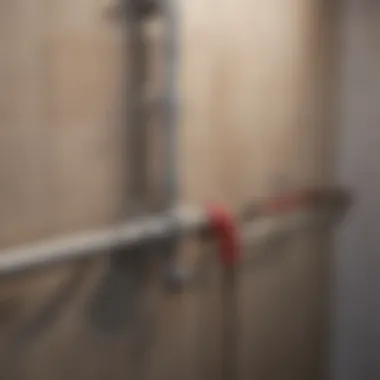Effective Solutions for Shower Drain Backups


Intro
Shower drain backups are a common household problem that many homeowners face. These backups can cause significant inconvenience and aggravation. Understanding the root causes and recognizing the signs early can save time and money. Maintaining clean drains is essential, and homeowners should be proactive. This article aims to explore the various reasons for shower drain backups and present practical solutions.
Common Causes of Shower Drain Backups
Several factors can lead to shower drain clogs. Identifying these causes helps in preventing future issues. Here are some key reasons:
- Hair Accumulation: One of the primary contributors to shower drain backups is hair. Over time, hair can clump together and create a dam that slows down water drainage.
- Soap Scum: Soap residue can mix with hair, and together they create a stubborn blockage. This residue can accumulate slowly, making it hard to detect until it’s too late.
- Foreign Objects: Items such as small bottles, toys, or other debris can obstruct the drain. They often get pushed down the drain accidentally.
- Pipe Damage: Over time, pipes can corrode or develop cracks. This damage can lead to serious drainage issues.
"Regular inspections of your plumbing can prevent small issues from becoming major headaches."
Practical Solutions for Drain Backups
When facing a shower drain backup, there are several methods homeowners can use to tackle the problem:
DIY Methods
- Plunger: Using a plunger can often dislodge minor clogs. Make sure it creates a good seal before plunging.
- Boiling Water: Pouring boiling water down the drain can dissolve soap scum and other debris.
- Baking Soda and Vinegar: This natural method involves pouring baking soda followed by vinegar. The reaction helps break down the buildup.
- Drain Snake: A drain snake can reach deeper clogs that a plunger can't access.
Professional Help
If DIY methods fail, it might be time to consult a professional plumber. They can:
- Perform a camera inspection to identify the issue.
- Use advanced tools to clear stubborn clogs.
- Check for underlying plumbing issues that might need repair.
Importance of Regular Maintenance
Neglecting drain maintenance can lead to severe problems. Regular upkeep can prevent major clogs, saving time and costly repairs. Here are some maintenance tips:
- Regular Cleaning: Clean the drain cover regularly to remove visible hair and debris.
- Use Drain Screens: Installing a drain screen can catch larger particles before they enter the plumbing system.
- Routine Inspections: Check plumbing for signs of corrosion or leaks.
Addressing shower drain backups may initially seem daunting, but with a proactive approach, homeowners can manage and prevent these issues effectively. Understanding how drains work and taking preventive measures will help maintain a stress-free shower experience.
Understanding Shower Drain Functionality
Understanding how shower drains work is essential for homeowners. A well-functioning shower drain contributes to the overall plumbing health of the house. This knowledge helps individuals identify potential problems early. The systems involved are often not visible and can lead to significant frustration if clogged.
Anatomy of a Shower Drain
Components of a shower drain
The shower drain consists of several key components. Primarily, these include the drain body, the strainer, and the trap. Each part plays a critical role in ensuring proper water flow. The drain body is typically made of durable materials such as PVC or metal. They are popular for their resistance to corrosion and longevity. The strainer helps catch debris, preventing it from entering the drainage system. This feature is crucial as it significantly reduces the chances of clogs.
How water flows through the system
Water flows through the shower drain system by gravity. After use, water collects in the shower base and then moves toward the drain. The design of the drain ensures that the water follows the path of least resistance. This efficient water flow helps maintain a clear pathway for drainage. Over time, if any component becomes blocked, this efficiency is compromised, leading to backups.
Common Terms and Definitions
Trap mechanisms
The trap is a fundamental component of the drainage system. It creates a seal that prevents sewer gases from entering the home. This is an important feature for health and safety. Traps are generally U-shaped, allowing water to remain inside. The characteristic of a trap mechanism is its ability to retain water, which acts as a barrier. However, improper maintenance can lead to foul odors or clogs.
Gravity and drainage
Gravity plays a significant role in how drainage systems function. It is the force that pulls water downwards through pipes. An effective gravity system ensures that water moves efficiently from the shower to the main sewer line. When gravity is involved, the alignment and slope of pipes become critical. Any misalignment can lead to slow drainage or backups, underlining the importance of proper installation.
Identifying Drain Backup Symptoms


Identifying symptoms of a shower drain backup is crucial for effective plumbing maintenance. Early recognition can prevent further complications, including extensive water damage and costly repairs. By understanding the typical indicators of a backup, homeowners can take proactive measures before the situation escalates. This section highlights the importance of recognizing these symptoms and the benefits of doing so.
Signs of Sluggish Drainage
Slow water drainage
Slow water drainage is often the first sign of a potential backup. When you notice that water takes longer than usual to drain, it suggests that some obstruction is beginning to form within the system. This symptom is detectable in daily routines. For instance, when the shower floor appears to remain wet long after use, this can indicate a blockage in the piping. The key characteristic of slow water drainage is persistence; it does not necessarily resolve quickly and can worsen over time.
The unique feature of this symptom lies in how it can indicate various issues, from minor clogs to more significant plumbing problems. Homeowners may find slow drainage beneficial to monitor, as an early intervention can be initiated before a complete blockage occurs. However, ignoring this sign may lead to more severe plumbing complications.
Unpleasant odors
Unpleasant odors emanating from the shower area signal decay or stagnant water in pipes. This condition arises when organic material, such as hair or soap scum, starts decomposing within the plumbing. The key characteristic of unpleasant odors is how they can permeate the entire bathroom. This makes it difficult to pinpoint the source without careful inspection.
The unique feature of this symptom is its ability to provide immediate feedback about water quality and hygiene issues. Addressing the source of the odor can be beneficial for not just plumbing but also general health. If left untreated, these odors tend to worsen and become more difficult to eliminate, leading to more complex drainage problems in the future.
Overflow and Displacement Issues
Water pooling around the shower
Water pooling around the shower is a concrete indicator of drainage issues. This symptom typically occurs when the drain system cannot handle the flow of water, leading to overflow. The key characteristic of water pooling is its visibility. Homeowners often notice this immediately, prompting a swift assessment of the situation.
The unique feature of water pooling around the shower lies in its potential to escalate into more damaging problems, such as mold growth and floor damage. It acts as a clear warning sign that something is amiss in the drainage system. This symptom is vital to address promptly as it could lead to significant maintenance challenges if ignored.
Visible water in adjacent fixtures
Seeing water in adjacent fixtures, like nearby sinks or toilets, suggests a broader plumbing issue. This symptom indicates that the backup may be more extensive than originally believed, as it shows how interconnected plumbing systems are. The key characteristic of this symptom is its ability to highlight systemic problems. Homeowners may realize that what seems like a localized issue is linked to the overall health of the plumbing system.
The unique feature of this symptom is the urgency it conveys. Visible water in other areas necessitates immediate action to prevent worsening conditions. It serves as a more serious alert that may require quick professional intervention before further damage occurs.
Recognizing these symptoms early can save time and money. Ignoring the signs often leads to more serious plumbing issues.
Common Causes of Shower Drain Backups
The topic of common causes of shower drain backups is crucial in understanding how to prevent and fix these plumbing issues. Identifying these causes helps homeowners take proactive steps. This section will explore several specific elements contributing to drain backups and will offer practical insight into how recognizing these factors can save time and prevent frustration.
Hair and Soap Buildup
The impact of hair clogs
Hair is one of the leading culprits of shower drain backups. Hair can easily accumulate and form dense clogs. This buildup restricts water flow, leading to sluggish drainage. The key characteristic of hair clogs is their tenacity. Hair links together with soap and other debris, creating a solid mass that is challenging to remove.
This aspect is essential for homeowners to understand. It can offer a beneficial choice for practical solutions discussed in this article. For instance, recognizing that hair is at the root of many clogs can motivate regular cleaning of the drain. Additionally, deploying preventive measures can significantly reduce the amount of hair entering the drain.
Soap scum accumulation
Soap scum is another significant factor contributing to shower drainage issues. When soap combines with minerals in water, it forms a sticky residue that adheres to the sides of pipes. This buildup can occur over time, gradually narrowing the drainage pathway. The unique feature of soap scum accumulation is its slow development yet cumulative effect.
For this article, understanding soap scum's impact is important. It serves as a reminder for homeowners to regularly clean their showers and drains. By doing so, they can limit soap scum and keep the drains flowing smoothly.
Foreign Objects
Small toiletries
Small toiletries such as shampoo caps, soap bars, and other items frequently end up in the drain. Their contribution to clogs is often underestimated. The key characteristic of these objects is their size, which can make them easily overlooked during cleaning routines. They tend to accumulate over time and can create significant blockages.
This is a relevant point for our discussion. Homeowners should be aware of where these items might land. Implementing strategies like storing toiletries out of the drain’s reach can be a simple yet effective preventative measure. It reduces the chances of foreign objects contributing to blockages.
Environmental debris
Environmental debris can also contribute to drain backups. Items like leaves, dirt, and dust may wash into the shower area and eventually the drain. The significance of environmental debris is its often unexpected arrival. Homeowners may not realize that debris can accumulate over time in addition to regular shower use.


Recognizing this type of clog is key. Preventive strategies, like using a drain cover to block larger debris from entering, can be beneficial. This simple step can save homeowners hassle in the long run.
Pipe Damage or Misalignment
Corroded pipes
Pipe corrosion is a serious issue that can lead to frequent backups. Corroded pipes can restrict water flow and create rough surfaces to catch debris. This unique feature can gradually worsen the drainage situation. The key characteristic of a corroded pipe is its long-term impact. It may take time for homeowners to realize the role corroded pipes play in clogs.
Being aware of this issue is crucial for our discussion. Regular inspections of plumbing can bring these problems to light early. Homeowners can mitigate costly repairs by addressing corroded pipes promptly.
Improper installation issues
Improper installation can lead to significant plumbing problems, including drain backups. Factors like incorrect pipe angles and insufficient slope can prevent proper drainage. This contributes to standing water within the drainage system. The key characteristic of installation issues is their potential to cause ongoing problems if not correctly addressed.
For readers, understanding the significance of proper installation provides insight into the importance of hiring qualified professionals for plumbing work. Avoiding common mistakes can greatly enhance the overall performance of shower drains.
Effective Solutions for Drain Backups
Addressing shower drain backups is crucial for maintaining a functional and hygienic bathroom environment. Recognizing how to effectively manage these issues can save homeowners time and money. Preventing backups can lead to reduced plumbing bills and fewer water damage incidents. Knowledge of efficient solutions empowers individuals to tackle minor drainage problems before they escalate. This section will explore various techniques and tools available for addressing drain backups.
DIY Unclogging Techniques
Using a plunger
Using a plunger is one of the most straightforward methods for unclogging shower drains. This tool operates on the principle of creating pressure, which can dislodge clogs caused by hair or soap scum. Its accessibility and ease of use make it a popular choice in many households.
The key feature of a plunger is its rubber suction cup, which forms a seal over the drain. When pushed and pulled, this suction helps to break apart the obstruction, potentially clearing the drain effectively. A major benefit of using a plunger is that it requires no chemical products, ensuring that the plumbing system remains safe from harmful substances.
However, the effectiveness of a plunger may vary depending on the severity of the blockage. It may not work well for deeper clogs located further along the plumbing. Therefore, homeowners should consider this as a primary step rather than a final solution.
Employing baking soda and vinegar
Employing baking soda and vinegar is another useful method for tackling drain clogs. This combination creates a chemical reaction that can help break down buildup within the pipes. It serves not only as a cleaning agent but also as a preventive measure against future clogs.
The unique feature of this method lies in its natural ingredients. Unlike harsh chemicals, baking soda and vinegar are non-toxic and friendly to the environment. They can effectively reduce odors while cleaning the plumbing system. This makes it a favored choice for families with children or pets.
One advantage of using this mixture is that it can target soap scum and minor clogs effectively, although severe blockages may still require stronger intervention. Homeowners should perform this treatment monthly to keep drains running smoothly.
Tools for the Task
Drain snake
A drain snake is a specialized tool designed to remove stubborn clogs that the plunger cannot handle. It consists of a long, flexible cable that can be inserted into the drain. As it reaches the blockage, it rotates and breaks it apart, allowing for effective removal. This tool is appreciated for its ability to reach deep into the plumbing system, often removing large clumps of hair or debris.
Its key characteristic is its flexibility, which allows it to navigate through curves in the pipe while maintaining effectiveness. This makes it a beneficial option for homeowners facing more serious drainage issues.
However, the disadvantage is that utilizing a drain snake requires some skill and care to avoid damaging the pipes. Homeowners unfamiliar with the tool should reference guides or tutorials before attempting its use.
Auger
An auger functions similarly to a drain snake but is typically more robust. It features an even longer and thicker coil, making it suitable for tackling tougher clogs. Using an auger may often resolve blockages that a standard drain snake cannot manage. Its ability to extend further into the plumbing system can clear heavy obstructions caused by years of buildup.
What sets an auger apart is its durable construction, designed for both commercial and residential use. It is a recommended tool for those who frequently face persistent drain problems. However, its use demands more effort and is generally better suited for individuals with some prior plumbing experience.
When to Seek Professional Help
Assessing the severity of the blockage
Recognizing when to seek professional help is an essential aspect of maintaining your plumbing system. Assessing the severity of the blockage can save homeowners from further damage and expensive repairs. If after using DIY methods there is no improvement, it may indicate a more serious issue that requires expert attention.


A key characteristic of assessing blockages is understanding the symptoms. If multiple drains are slow, it may suggest that the problem lies deeper in the plumbing system. In such high-severity cases, professional intervention is necessary.
This approach can prevent additional problems like pipe burst or water damage, representing a wise investment for the home.
Signs of plumbing system failure
In addition to blockage assessment, recognizing signs of plumbing system failure is critical. Symptoms such as unusual noises from pipes, persistent bad odors, or water pooling around fixtures are indicators that professional help is warranted. Addressing these signs early can greatly reduce repair costs and ensure the safety of the home environment.
The primary benefit of being vigilant about these indicators is the opportunity for timely repairs. Homeowners can avoid significant plumbing issues by acting quickly. Waiting too long can result in more extensive damage and higher repair bills.
In summary, understanding effective solutions to shower drain backups allows homeowners to take charge of their plumbing issues. Utilizing simple tools and techniques can lead to less frequent problems and a more pleasant home environment.
Preventive Measures for Drain Maintenance
Preventive measures are essential to avoid the complications associated with shower drain backups. By implementing proactive strategies, homeowners can significantly reduce the frequency and severity of such issues. Not only does this save time and money in the long run, but it also promotes a more efficient plumbing system. Regular maintenance is a worthwhile investment in overall household hygiene. It ensures that your shower operates smoothly without unnecessary interruptions. This section will outline specific practices that can lead to successful drain maintenance.
Regular Cleaning Practices
Routine hair and debris removal
Routine hair and debris removal is an indispensable practice in shower drain maintenance. Hair is often the primary culprit of drain blockages. It accumulates gradually and can create substantial clogs in the pipes. By regularly inspecting and cleaning the drain, homeowners can prevent build-up before it becomes a serious problem.
The key characteristic of this practice is its simplicity. It only requires basic tools, like a pair of gloves and a small scoop or a screen. This characteristic makes it a popular choice for many homeowners. It is beneficial because the procedure can be completed with minimal disruption to daily routines.
Furthermore, removing visible hair and debris at frequent intervals reduces the need for more complex and hazardous methods later. The unique feature of routine cleaning is its accessibility; anyone can perform this task. The advantages include maintaining a functional drainage system and prolonging the life of plumbing. However, it may become tedious for some, making it essential to integrate this into regular cleaning schedules efficiently.
Monthly maintenance with home solutions
Monthly maintenance using natural home solutions is another effective measure for drain upkeep. Using simple ingredients such as baking soda and vinegar can effectively clean the pipes without resorting to harsh chemicals. This method not only clears minor clogs but also maintains freshness within the drain system.
The significant aspect of this approach is that it minimizes the risk of toxic exposure. Using readily available household items is an effective and environmentally friendly way to address potential issues. This is why it has gained popularity among those who prioritize health alongside home maintenance.
Unique to this practice is its capability to break down soap scum and grease, often lurking in pipes. The advantages of using home solutions include cost-effectiveness and ease of access to materials. The disadvantage can be that while it offers minor cleaning benefits, it might not fully resolve severe blockages requiring professional help.
Installation of Drain Covers
Types of drain covers
Types of drain covers play a vital role in reducing the risk of clogs. These range from simple mesh screens to more advanced options like pop-up or hinged drain covers. Each type helps trap debris efficiently while allowing water to flow freely. This characteristic makes the choice of a suitable cover crucial for effective prevention.
Adopting drain covers is highly beneficial due to their capability to minimize hair and foreign object entry into the plumbing system. They serve as a first line of defense against common clogging problems, enhancing the overall lifespan of drains. The unique feature lies in their versatility; they come in a variety of designs to suit different shower styles. The main disadvantage is that they require regular cleaning to remain effective.
Benefits in clog prevention
The benefits of effective drain cover installation significantly contribute to clog prevention. They act as barriers that stop large particles from entering the drainage system while permitting water to flow. This characteristic is critical as it directly correlates with reduced maintenance needs over time.
They are a popular choice due to their simplicity and efficiency. Installing them is straightforward, allowing homeowners to incorporate them into their daily routines effortlessly. The unique feature of these covers is the protective layer they provide for the plumbing system. Their advantages include not only reduced clogging but also saving on costly plumbing repairs that come with serious backups.
However, it is essential to note that drain covers must be monitored regularly for build-up. Ignoring this can lead to unintended blockages despite the protective measure, so consistent cleaning remains necessary.
The End and Summary
Addressing shower drain backups is crucial for homeowners in maintaining a functional and pleasant bathing environment. This article has highlighted several key aspects of the problem, starting from understanding how shower drains work, identifying symptoms of potential issues, to recognizing the common causes and effective solutions for preventions. A well-maintained drainage system enhances the overall hygiene and comfort of the bathroom.
Importance of the Topic: Understanding shower drain backups involves not just recognition of physical disruptions in water flow, but also an awareness of the various elements that contribute to these issues. By engaging in regular maintenance and recognizing early signs of blocks, homeowners can save themselves both time and expense.
Additionally, this article has established a clear link between preventive measures and the minimization of future repairs. Practical steps such as regular cleaning practices and thoughtful installation of drain covers can significantly decrease the likelihood of drain backups.
"Taking proactive measures ensures your plumbing remains effective and odor-free, promoting a healthier living space."
The evaluation of scenarios requiring professional assistance cannot be overlooked. Some drain issues may indicate deeper plumbing system failures, which require expertise. Being informed increases the likelihood of timely intervention and reduces potential damages to property.
In synthesis, understanding, recognizing, and preventing shower drain backups not only contributes to the functionality of a home’s plumbing but also enhances the overall quality of life for its residents. By applying the knowledge shared within this article, homeowners can effectively navigate drain-related challenges.
Key Takeaways
- Recognition of Symptoms: Identifying slow drainage and unpleasant odors early can help catch potential backups before they escalate.
- Common Causes: Hair, soap buildup, foreign objects, and pipe issues are the main culprits behind these blockages.
- Effective Solutions: Employing DIY methods when feasible, while knowing when to call professionals, is vital for maintaining a healthy drainage system.
- Preventive Measures: Regular cleaning and the use of drain covers are critical steps that prevent blockages from occurring.
- Importance of Awareness: Understanding your system allows for better maintenance and quicker responses to issues, fostering a healthy and operational plumbing system.







